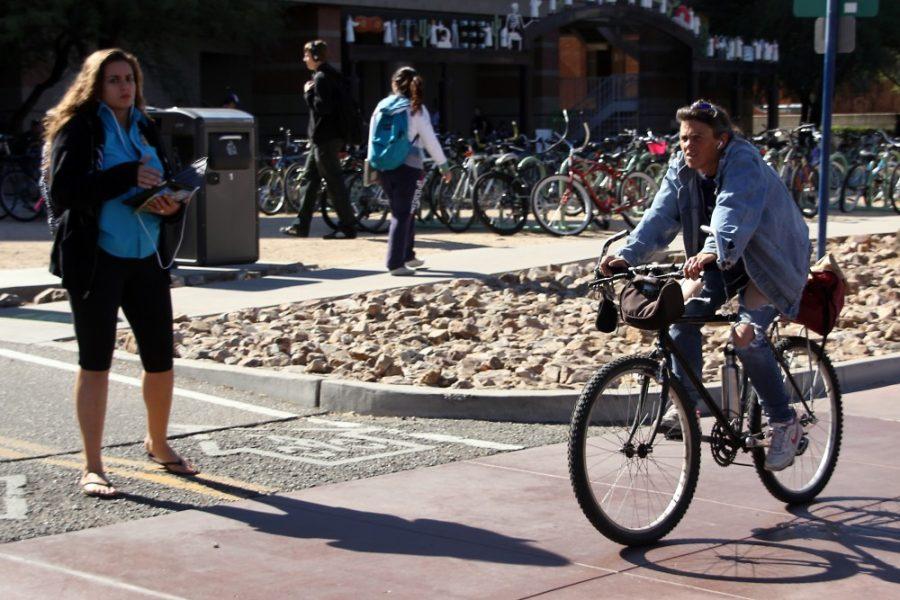A UA-area study will try to make the campus and its surrounding neighborhoods safer for bicyclists and pedestrians, just a month after a student had a seizure after being struck by a bicyclist.
The Pima Association of Governments and the UA will fund the $100,000 UA Area Bicycle and Pedestrian Study. Student surveys, bike counts and other data will help reduce collisions, improve existing infrastructure and better the flow of bike and pedestrian traffic, said Tom Amparano, transportation manager for Parking and Transportation Services and the study’s co-project manager.
“Safety is paramount and we want to actually get something out of this,” Amparano said. “It’s a study slash plan.”
Michael McKisson, an adjunct instructor in the School of Journalism and cyclist who runs Tucsonvelo.com, a cycling website, said the study is needed.
“When I ride through campus, it’s not the UA’s infrastructure I’m worried about,” McKisson said. “Pedestrians are walking with their faces buried in their cellphones, bicyclists are chatting with their friends … something needs to be done.”
Campus crashes over the last few years make the study all the more necessary, McKisson said.
“We get into a hurry because, ‘I got to get to class’ and that sort of thing,” McKisson said. “Being five minutes late is better than running someone over.”
“Choke points,” where safety is a bigger problem, include the circle around Old Main, in front of the Harvill building and between Highland Avenue and Second Street. These areas will receive extra attention, Amparano said. Raising awareness on bike and pedestrian safety is a study priority and key to reducing accidents.
Jose Rangel, a media arts sophomore, said the area around the Student Union Memorial Center is crammed with bicyclists and pedestrians and the study should find ways to expand that segment of campus. Another problem is bicyclists flying past stop signs, which they do when there are no cars or cops around, he said.
Roughly 11,500 bicyclists ride through campus every day, meaning the UA has the highest concentration of bicyclists in the Tucson metro area, Amparano said. Anthony Nguyen, a chemistry sophomore, said he worries about hitting one of them when he’s driving because many are careless.
Bicyclist Edward Gonzales, a junior studying material science and engineering, said he constantly deals with pedestrians walking in the bike lane and has almost crashed into a few of them. He said other than potholes, the UA’s infrastructure is fine and the study should focus more on reminding pedestrians to pay attention when they’re walking.
“Make them more aware that we’re riding our bikes here, don’t get in our way or you might get hit,” he said.
Ahmed Elhag, a pre-business freshman, said he stopped riding his bike after two weeks for several reasons, one being the difficulty of maneuvering through people.
Most bicyclists and pedestrians probably break rules because they’re unaware of them, Elhag said.
Bicyclists call the area on University Boulevard between the Main Library and Old Main around 11:50 a.m. when classes are out “the gauntlet,” McKisson said.
“There’s thousands of people riding bikes, walking … it’s a gauntlet of craziness,” McKisson said. “You’ve got to figure out a better way of mixing walking, biking and driving on campus.”
Amparano said it’s too early to identify specific improvements or how much they’ll cost, but funding and community input are big factors in determining them.
The first open house for public input will be Jan. 26 in the Student Union Memorial Center’s Catalina Room from 11 a.m. to 2 p.m., said Bill Davidson, marketing manager for PTS. The study will have long-term impacts on the UA and its surrounding neighborhoods. It’s important to hear all sides of the issues, he added.
“We may have to restrict pedestrians and bicycles to different sides of the Mall,” Amparano said. “We want ideas, this is why we’re looking at the study. I don’t want to preclude anything right now, I want to keep an open mind.”









